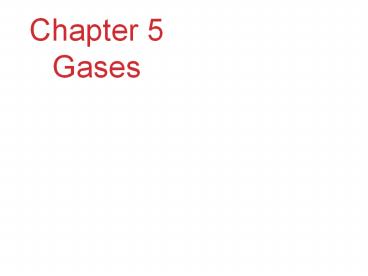Chapter 5 Gases - PowerPoint PPT Presentation
1 / 27
Title: Chapter 5 Gases
1
Chapter 5Gases
2
Characteristics of Gases
- Unlike liquids and solids, they
- Expand to fill their containers.
- Are highly compressible.
- Have extremely low densities.
3
Pressure
- Pressure is the amount of force applied to an
area.
- Atmospheric pressure is the weight of air per
unit of area.
4
Units of Pressure
- Pascals
- 1 Pa 1 N/m2
- Bar
- 1 bar 105 Pa 100 kPa
- mm Hg or torr
- These units are literally the difference in the
heights measured in mm (h) of two connected
columns of mercury. - Atmosphere
- 1.00 atm 760 torr
5
Manometer
- Used to measure the difference in pressure
between atmospheric pressure and that of a gas in
a vessel.
Manometer at lt, , gt P of 1 atm
6
Standard Pressure
- Normal atmospheric pressure at sea level.
- It is equal to
- 1.00 atm
- 760 torr (760 mm Hg)
- 101.325 kPa
7
Boyles Law
- The volume of a fixed quantity of gas at
constant temperature is inversely proportional to
the pressure.
Gas Laws animation and plot PV, PT, VT
8
As P and V areinversely proportional
- A plot of V versus P results in a curve.
9
Charless Law
- The volume of a fixed amount of gas at constant
pressure is directly proportional to its absolute
temperature.
A plot of V versus T will be a straight line.
10
Avogadros Law
- The volume of a gas at constant temperature and
pressure is directly proportional to the number
of moles of the gas.
11
Ideal-Gas Equation
- So far weve seen that
- V ? 1/P (Boyles law)
- V ? T (Charless law)
- V ? n (Avogadros law)
12
Ideal-Gas Equation
- The constant of proportionality is known as R,
the gas constant.
13
Ideal-Gas Equation
- The relationship
then becomes
or
PV nRT
14
Densities of Gases
- If we divide both sides of the ideal-gas
equation by V and by RT, we get
15
Densities of Gases
- We know that
- moles ? molecular mass mass
n ? ? m
- So multiplying both sides by the molecular mass
(? ) gives
16
Densities of Gases
- Mass ? volume density
- So,
- Note One only needs to know the molecular mass,
the pressure, and the temperature to calculate
the density of a gas.
17
Molecular Mass
- We can manipulate the density equation to enable
us to find the molecular mass of a gas
Becomes
18
Daltons Law of Partial Pressures
- The total pressure of a mixture of gases equals
the sum of the pressures that each would exert if
it were present alone.
- In other words,
- Ptotal P1 P2 P3
19
Partial Pressures
- When one collects a gas over water, there is
water vapor mixed in with the gas.
- To find only the pressure of the desired gas, one
must subtract the vapor pressure of water from
the total pressure.
20
Kinetic-Molecular Theory
- This is a model that aids in our understanding
of what happens to gas particles as environmental
conditions change.
21
Main Tenets of Kinetic-Molecular Theory
- Gases consist of large numbers of molecules that
are in continuous, random motion. - The combined volume of all the molecules of the
gas is negligible relative to the total volume in
which the gas is contained. - Attractive and repulsive forces between gas
molecules are negligible. - Energy can be transferred between molecules
during collisions, but the average kinetic energy
of the molecules does not change with time, as
long as the temperature of the gas remains
constant. - The average kinetic energy of the molecules is
proportional to the absolute temperature.
22
Boltzman Distribution
- The average kinetic energy of the molecules is
proportional to the absolute temperature.
Boltzmann distribution plot
23
Effusion
- The escape of gas molecules through a tiny hole
into an evacuated space.
24
Diffusion
- The spread of one substance throughout a space
or throughout a second substance.
Diffusion of bromine vapor clip
25
Real Gases
- In the real world, the behavior of gases only
conforms to the ideal-gas equation at relatively
high temperature and low pressure.
26
Deviations from Ideal Behavior
- The assumptions made in the kinetic-molecular
model break down at high pressure and/or low
temperature.
Real gases animation at different temperatures
27
Corrections for Nonideal Behavior
- The ideal-gas equation can be adjusted to take
these deviations from ideal behavior into account.
- The corrected ideal-gas equation is known as the
van der Waals equation.































